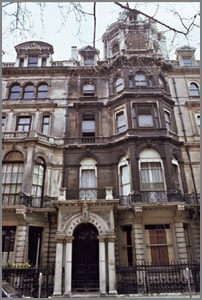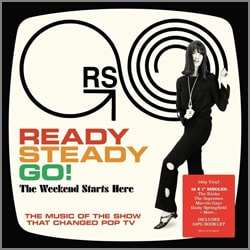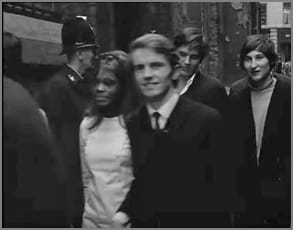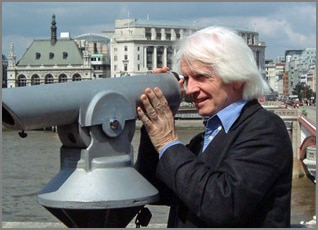My times with Radio Caroline
by Wyck Gerson Lohman
Photographer Rolf van Brandtzaeg was one of the people who started the offshore station Radio Caroline. Working as a senior executive at Caroline’s London office, he stayed behind the scenes and always remained a rather mysterious man. Here Wyck Gerson Lohman, himself a photographer and professionally known as Gershon, recollects some anecdotes about the man and some other people he met during his time at Caroline House.

A perfect photo-studio. One of my fellow students at the photography school was a Swede. His name was Rolf van Brandtzaeg. How his name acquired the seemingly Dutch “van”, I have no idea. He must have lived in the UK for a reasonably long time because he spoke an almost posh English, with only a touch of a Swedish accent. He owned a red sports car, an MG, and sometimes we would go places together to take pictures on location, in which case he would suggest that if I bought some rolls for lunch he would take care of the fillings. He was friends with the Swedish Ambassador who was in the habit of having his favourite food flown over from his home country. Sometimes he would give his leftovers to Rolf and that is how our rolls might be garnished with Crayfish or even Caviar. After our schooldays we kept in contact. At some point it turned out that he was one of the initiators behind Radio Caroline. Although the programmes were broadcast from the “pirate ship,” much, especially the interviews, was recorded at “Caroline House,” a magnificent multi-storey building in Chesterfield Gardens, Mayfair, one of the most expensive parts of the West End.
Once Radio Caroline was up and running, Rolf took possession of the top floor where he set up a perfect photo-studio which, in time, he allowed me to use as well. That is how I became a fashion and make-up photographer despite the fact that I never had the slightest interest in fashion. I still haven’t, but my reasoning was that it is an advantage for a fashion photographer to know nothing about fashion since it puts you in a position where any garment you are asked to photograph is new to you so you can regard it with the neutrality needed to be able to show it off to its best advantage. I still believe there is at least some truth in this. Whenever I looked at my work decennia later I did feel that I could, with honestly, conclude that my 60s and 70s work was less dated than that of even some of the most celebrated photographers of that era. Unfortunately I can no longer prove this since, in 2009, all my work went up in flames.

Meeting the stars. Of course the result of the studio being based at Caroline House was that you met various pop stars. So I helped produce the record sleeves of a number of singers and pop groups of the 1960s and became friends with Hilton Valentine, lead guitarist of The Animals. When The Animals moved from Newcastle to London they shared a flat together and when a room became available there, I moved in. One day I was approached by Chas Chandler, the bass guitarist, who asked me if I could take some pictures for him of a new talent, just flown in from the States. This musician had recently signed up to be managed by him. That is how, for a few days, I came to hang out with a friendly Afro-American with a fairly wild hairdo. I would have liked to have photographed him with open shirt, as that would have suited his image, but I was not allowed to do that. The reason was that before he had come to England, he had played in the backing-group of Little Richard, who was, supposedly, in the habit of underpaying his musicians, which left the newly signed up talent somewhat malnourished. “Ready, Steady, Go,” was undoubtedly the most viewed programme on TV in those days. Every budding pop artist was dying to appear on it. That evening Hilton Valentine, Eric Burdon, the new talent’s girlfriend and I were sitting in front of the TV anticipating his first appearance. Half an hour later he was the talk of the town, all over the UK. His name was Jimi Hendrix.
Ronan O’Rahilly, founder of Radio Caroline, was an Irishman. In appearance he could easily have been a Kennedy, Bobby Kennedy’s twin brother. He worshipped John F. Kennedy who had been murdered a few years previous. On Ronan’s desk stood the massive bust of John F. Kennedy and he had chosen the name Caroline for the radio station because that was the name of Kennedy’s daughter. He could tell you everything about Kennedy’s murder, anything that even those whose job it had been to get to the bottom of the killing, were not aware of and if you asked him how he knew all that he would give you a piercing look and answer: “Because I was there!” — this in a way as if to say: “Don’t you see who you have in front of you? John F. Kennedy, that is me!”

In the wake of Harold Wilson. The Cavern Club in Liverpool was where The Beatles were the resident band before they gained their popularity. At some point the club was closed down, but later on a new Cavern Club was set up which was to be opened on the 23th July 1966 by Prime Minister Harold Wilson. Ronan O’Rahilly hated Harold Wilson from the bottom of his heart. That was because Wilson was in the process of passing a bill to banish all pirate stations. Despite that Ronan, Rolf, Rolf’s girlfriend and I decided to go to the opening. After we had got on the train and were looking for a seat we passed Harold Wilson who was sitting there accompanied by a small group of women. He was travelling second class, without security as there was no need for that in those days. As soon as we were out of sight, and especially out of earshot, Ronan began to fume: “I could kill that man!” Happily he did not do so, but when we got to Liverpool we did not have the faintest idea where to go, so we simply followed Harold Wilson and his crew who guided us to the right location. The next evening I had a phone call from an old friend in Amsterdam who asked me: “What the hell were you doing in the wake of Harold Wilson?” He had watched the opening of the Cavern Club on a Dutch news programme.
After Radio Caroline’s vessel was eventually chained up, Ronan O’Rahilly set up an agency to represent actors, which did well initially. Even one of the James Bonds, George Lazenby, was on his books. But Lazenby only played him once, unfortunately. The reason was that Ronan was of the opinion that Bond had had it, old hat! So he advised Lazenby to drop Bond and focus on more lucrative parts. Roger Moore, who played Bond seven times after that, must have been very pleased with the advice that was given to his predecessor. Sadly Ronan died of vascular dementia on 20th April 2020.

Epilogue. In the week after The Animals got back from a tour in Sweden, two Swedish girls, Lotte and Yvonne, knocked on the door of the flat. They had been given the address by Chas Chandler and Hilton Valentine. A year later Chas married Lotte, but the affair between Hilton and Yvonne soon petered out. For a while I kept in contact with Yvonne even after she moved to Wimbledon with Gip who was pop singer Donovan’s best friend.
Meanwhile, at my brother’s wedding in Amsterdam in the Summer of Love, 1967, I had met Toej. Back in London a friend of mine asked me if I felt like accompanying him on a trip by car to Sweden, via Amsterdam. I asked Toej if she wanted to come along, but she could not take the time off her work, so I decided to stay in Amsterdam to be picked up on the way back. But Yvonne and Gip took up the offer of a lift all the way to Sweden, so that is how Toej got to meet the slightly hippyish Yvonne in Amsterdam. Whenever Yvonne saw something she liked, such as a colourful, well decorated gateau, she would point her finger at it and say in a pleading little girl’s voice: “I want that one …”
Toej is a good imitator, so she could do a perfect “Yvonne” and continued to do them over the years. That is how our daughter, Natasha, who had never met her, of course, was aware that it was the Swedish Yvonne who was being imitated. When she was 15-years-old, Natasha took a summer job in the “Quarry Café,” the eco-friendly café in Machynlleth, which was run by “the Centre for Alternative Technology.” Machynlleth is well over 200 miles from London, where I had last seen Yvonne. A middle aged lady comes to the counter. She points at a colourful little gateau and Natasha hears her say in little girl’s voice that sounds strangely familiar to her: “I want that one …” “Is your name Yvonne by any change?” asks Natasha. It was!
From: Soundscapes — Journal on Media Culture (ISSN 1567-7745)
volume 21 june 2020
